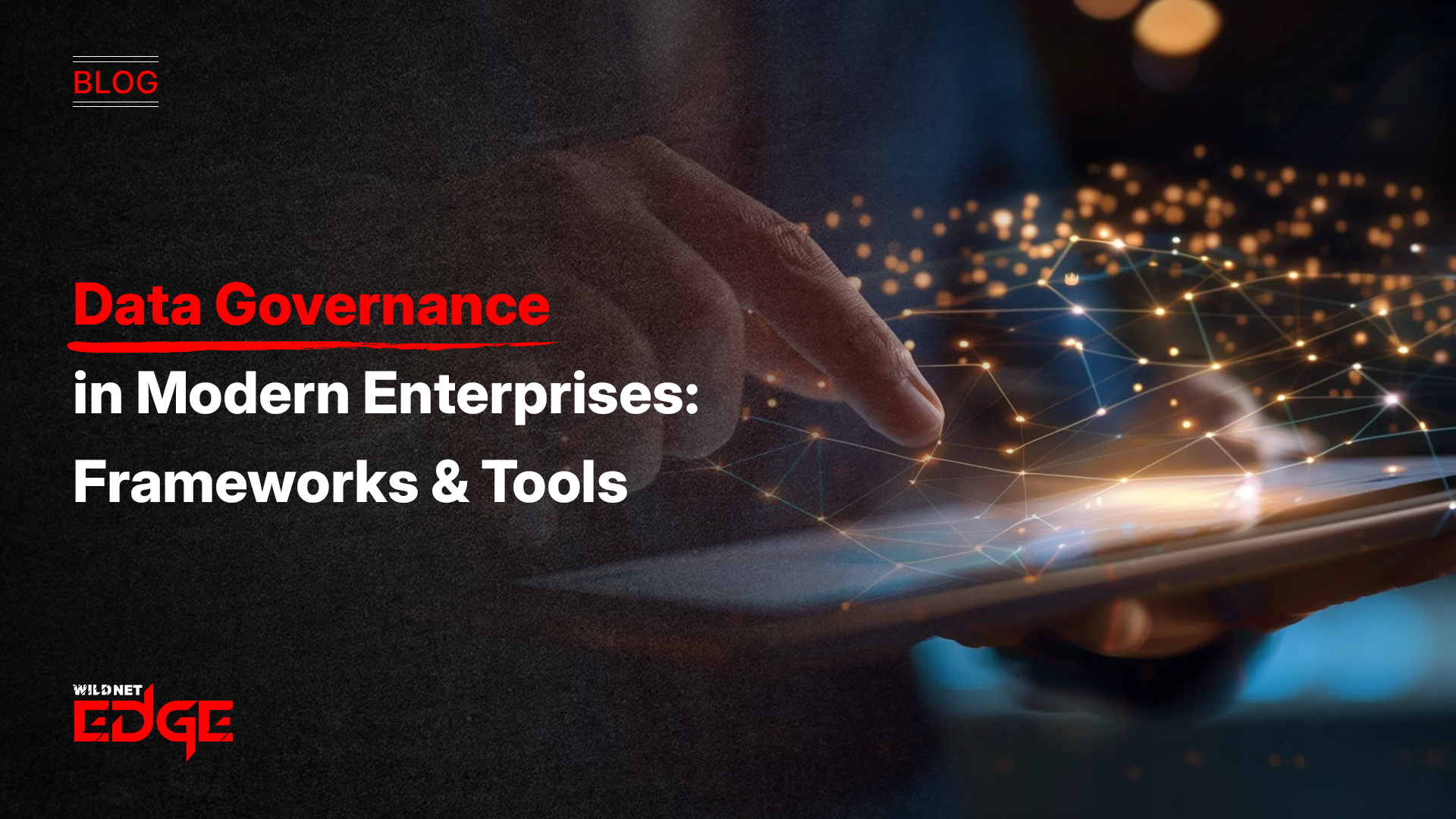Struggling to keep your data organized, compliant, and valuable? You’re not alone. Modern enterprises face constant challenges managing vast amounts of data while staying compliant with regulatory demands that evolve constantly. That’s where data governance steps in — a strategic approach to untangling your data chaos, minimizing risks, and driving business growth. In this post, we’ll break down key data governance frameworks and tools that help enterprises stay ahead and fully compliant while optimizing their enterprise data management.
Enterprise Data Management: The Foundation of Modern Data Governance
Enterprise data management (EDM) refers to the comprehensive approach organizations use to acquire, manage, store, and deliver data across the business. It serves as the backbone for any effective data governance program.
At its core, EDM ensures that data is treated as a strategic asset by unifying data sources, streamlining processes, and fostering data consistency across departments. Without EDM, data governance becomes ineffective due to fractured data silos and inconsistent standards.
Why Enterprise Data Management is Critical for Data Governance
- Unifying Data for Governance: EDM provides a single source of truth by integrating data across the enterprise—be it structured or unstructured—making enforcement of governance policies possible.
- Aligning Business and Data Goals: EDM ensures data initiatives are closely tied to key business objectives such as customer insights, operational efficiency, and risk mitigation. This alignment enables governance frameworks to prioritize relevant data policies.
- Foundation for Compliance: By managing data lifecycle and security protocols centrally, EDM equips enterprises to meet stringent data compliance regulations more easily, reducing penalties and reputational damage.
Aligning Business Goals with Data Management Strategies
Businesses today leverage EDM to unlock data’s full potential — enabling initiatives like AI-driven analytics, enhanced customer experiences, and operational agility. To do this effectively requires:
- Clear Data Ownership Models: Defining responsibilities for data creation, maintenance, and governance.
- Policy Enforcement Automation: Embedding governance rules into enterprise applications and workflows.
- Continuous Monitoring: Using advanced tools to observe data usage, quality, and compliance in real time.
Together, these practices elevate enterprise data management from a technical function to a strategic driver of value—empowering organizations to govern data proactively, not reactively.
Ensuring Data Compliance Through Effective Governance Frameworks
The rise of global data privacy and security regulations makes data compliance a top priority for modern enterprises. Effective data governance frameworks form the structural backbone to navigate this complex landscape.
Major Compliance Regulations Impacting Enterprises in 2025
- GDPR (General Data Protection Regulation): EU law requiring strict consent, data subject rights, and breach reporting.
- CCPA (California Consumer Privacy Act): Mandates transparency and consumer rights around personal data in California.
- HIPAA (Health Insurance Portability and Accountability Act): Governs patient data privacy and security in healthcare.
- Others: Emerging regulations in APAC, Latin America, and industry-specific rules necessitate customizable compliance controls.
Key Components of Data Governance Frameworks Focused on Compliance
- Policies: Formalized rules outlining data handling, access, retention, and privacy standards customized per regulation.
- Roles and Responsibilities: Clearly defined data stewards, custodians, and owners accountable for governance processes.
- Controls and Enforcement: Implementation of automated checks, audits, and workflows to assure regulatory adherence.
- Risk Management: Continuous assessment to identify compliance gaps and remediate proactively.
Framework Examples Supporting Compliance
- DAMA-DMBOK (Data Management Body of Knowledge): A comprehensive data governance framework providing best practices across data quality, privacy, and metadata management. It emphasizes establishing strong data policies and stewardship to maintain compliance.
- COBIT (Control Objectives for Information and Related Technologies): Focused on IT governance with controls targeting risk, compliance, and value delivery, often integrated with data governance programs.
By adopting frameworks like DAMA-DMBOK or COBIT, enterprises build repeatable processes that reduce regulatory risks and help maintain a compliant data ecosystem efficiently.
Essential Tools for Streamlining Data Governance
Implementing data governance without the right technology is impossible at scale. Today’s enterprises deploy a suite of specialized tools designed to simplify governance tasks, ensure data compliance, and enhance enterprise data management.
Data Cataloging and Metadata Management Tools
Data catalogs serve as a centralized inventory of enterprise data assets, making data discoverable and understandable. They capture metadata — data about data — enabling users to contextualize data origin, format, and lineage.
- Top tools in 2025: Collibra, Alation, and Informatica Axon.
- Benefits: Facilitates data stewardship, policy enforcement, and audit readiness by providing visibility into where sensitive or regulated data resides.
Data Quality and Monitoring Platforms
High-quality data is a prerequisite for successful governance and compliance. Automated platforms continuously measure data accuracy, completeness, and timeliness — detecting anomalies before they escalate into compliance or operational risks.
- Tools like Talend Data Quality and IBM InfoSphere QualityStage excel at profiling data sets against desired quality standards.
Access Control and Audit Trail Solutions
Regulatory frameworks often require strict control over who can view or modify sensitive data, along with detailed audit logging.
- Role-based access control (RBAC) and attribute-based access control (ABAC) systems, powered by providers such as SailPoint and Okta, simplify secure data access.
- Audit logging solutions ensure immutable records for every data transaction, supporting forensic analysis and compliance audits.
Integration with Compliance Management Software
Many governance tools seamlessly integrate with compliance automation platforms like MetricStream or RSA Archer, allowing unified risk and compliance management workflows.
Together, these tools form an ecosystem that empowers enterprises to enforce policies, demonstrate compliance, and maintain high data quality continuously.
Trends and Advanced Tactics in Data Governance for Enterprises
As the data landscape evolves, so does data governance. Leading enterprises adopt innovative trends and advanced tactics to keep pace.
AI and Machine Learning to Automate Governance
Artificial intelligence increasingly automates labor-intensive governance activities:
- Automated Data Classification: ML models identify and tag sensitive data such as PII or PHI without manual input.
- Anomaly Detection: AI systems monitor data flows to detect suspicious access or breaches in real time.
- Automated Compliance Checks: Continuous scanning and validation against regulatory requirements reduce manual audits.
This AI-driven approach not only scales governance but improves accuracy and response speed.
Growing Importance of Data Stewardship and Cross-Functional Teams
Modern data governance extends beyond IT. Organizations establish cross-functional governance councils bringing together data stewards from business, legal, compliance, and IT functions.
- This collaborative approach ensures policies align with real-world operations.
- Data stewards act as proactive custodians, bridging the gap between governance strategy and execution.
Adoption of Cloud-Native Governance Tools
With enterprises increasingly adopting hybrid and multi-cloud environments, cloud-native data governance platforms become indispensable.
- Solutions like Microsoft Purview and Google Cloud Data Catalog provide native integrations with cloud storage, analytics, and security services.
- These tools offer unified governance across on-prem, cloud, and SaaS data sources, reducing complexity.
Conclusion
Data governance is no longer optional — it’s essential for modern enterprises striving to ensure data compliance and optimize enterprise data management. By adopting proven governance frameworks like DAMA-DMBOK, and leveraging advanced AI-powered tools, organizations transform data from an unwieldy liability into a strategic asset that propels business success.
Navigating today’s stringent regulations and complex data environments requires trusted expertise and technology. WildnetEdge stands as a reliable partner on this journey, delivering tailored solutions to implement robust data governance that meets and exceeds today’s rigorous standards.
Ready to take control of your data and turn governance into a competitive advantage? Connect with WildnetEdge to learn how to elevate your data governance strategy.
FAQs
Q1: What is data governance and why is it important for enterprise data management?
Data governance refers to the policies, processes, and standards that ensure data accuracy, security, and usability. It is vital for enterprise data management because it maintains data quality and compliance across the organization, ensuring that data remains a trustworthy asset.
Q2: How does data governance help with data compliance?
Data governance establishes frameworks and controls that enforce regulatory requirements, such as data privacy and protection laws (GDPR, CCPA, HIPAA). This minimizes risk, enables audit readiness, and ensures the organization meets its legal obligations.
Q3: What are some common tools used for data governance in enterprises?
Common tools include data catalogs for metadata management, data quality monitoring platforms, access control systems, audit trail solutions, and compliance management software integrated for streamlined governance.
Q4: Can AI improve data governance practices?
Absolutely. AI automates data classification, anomaly detection, and compliance monitoring tasks, enhancing efficiency, scalability, and reducing errors in governance programs.
Q5: How do frameworks like DAMA-DMBOK support data governance?
Frameworks like DAMA-DMBOK provide a structured set of best practices and guidelines that help organizations design, implement, and maintain effective data governance initiatives, covering data quality, privacy, stewardship, and management processes.

Nitin Agarwal is a veteran in custom software development. He is fascinated by how software can turn ideas into real-world solutions. With extensive experience designing scalable and efficient systems, he focuses on creating software that delivers tangible results. Nitin enjoys exploring emerging technologies, taking on challenging projects, and mentoring teams to bring ideas to life. He believes that good software is not just about code; it’s about understanding problems and creating value for users. For him, great software combines thoughtful design, clever engineering, and a clear understanding of the problems it’s meant to solve.
 sales@wildnetedge.com
sales@wildnetedge.com +1 (212) 901 8616
+1 (212) 901 8616 +1 (437) 225-7733
+1 (437) 225-7733































